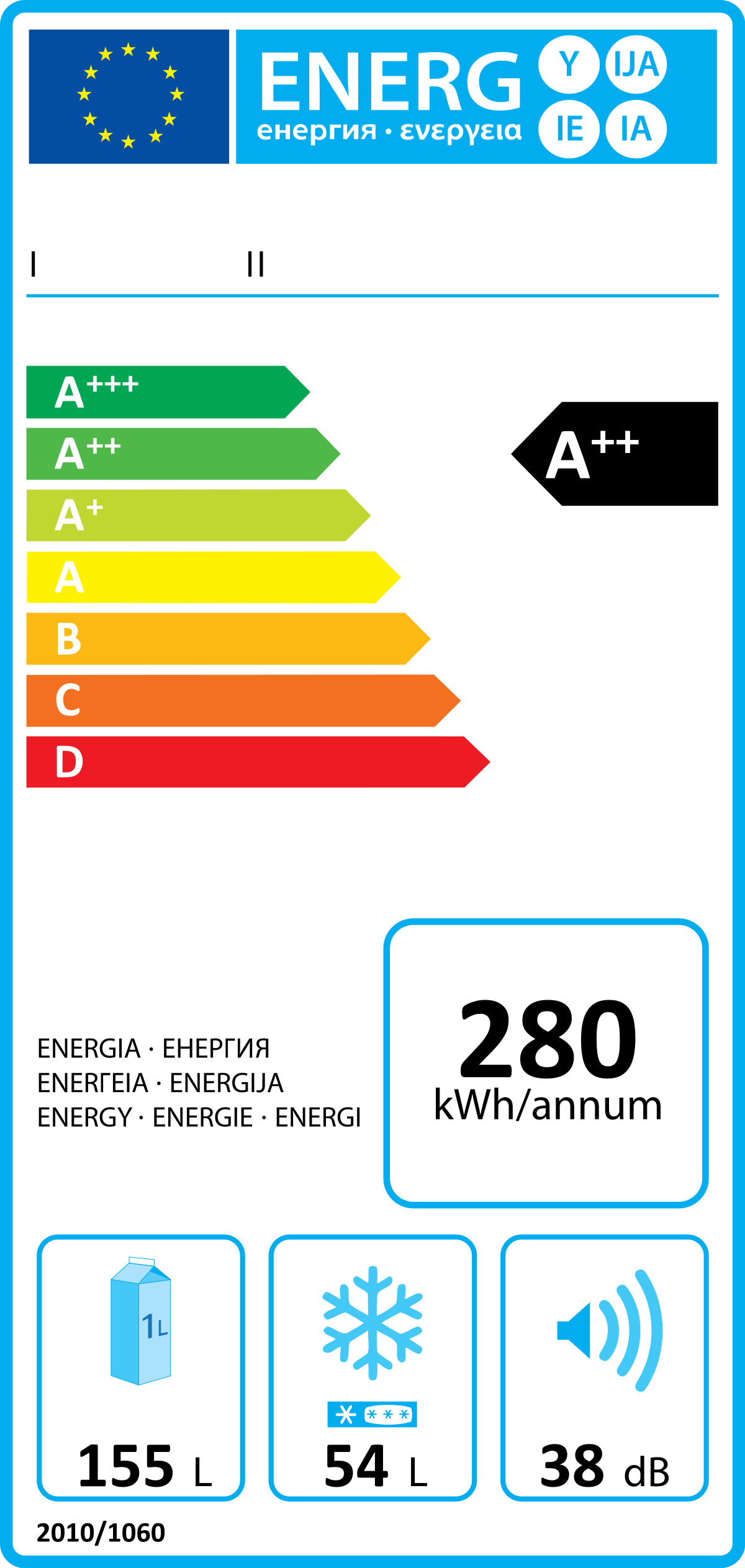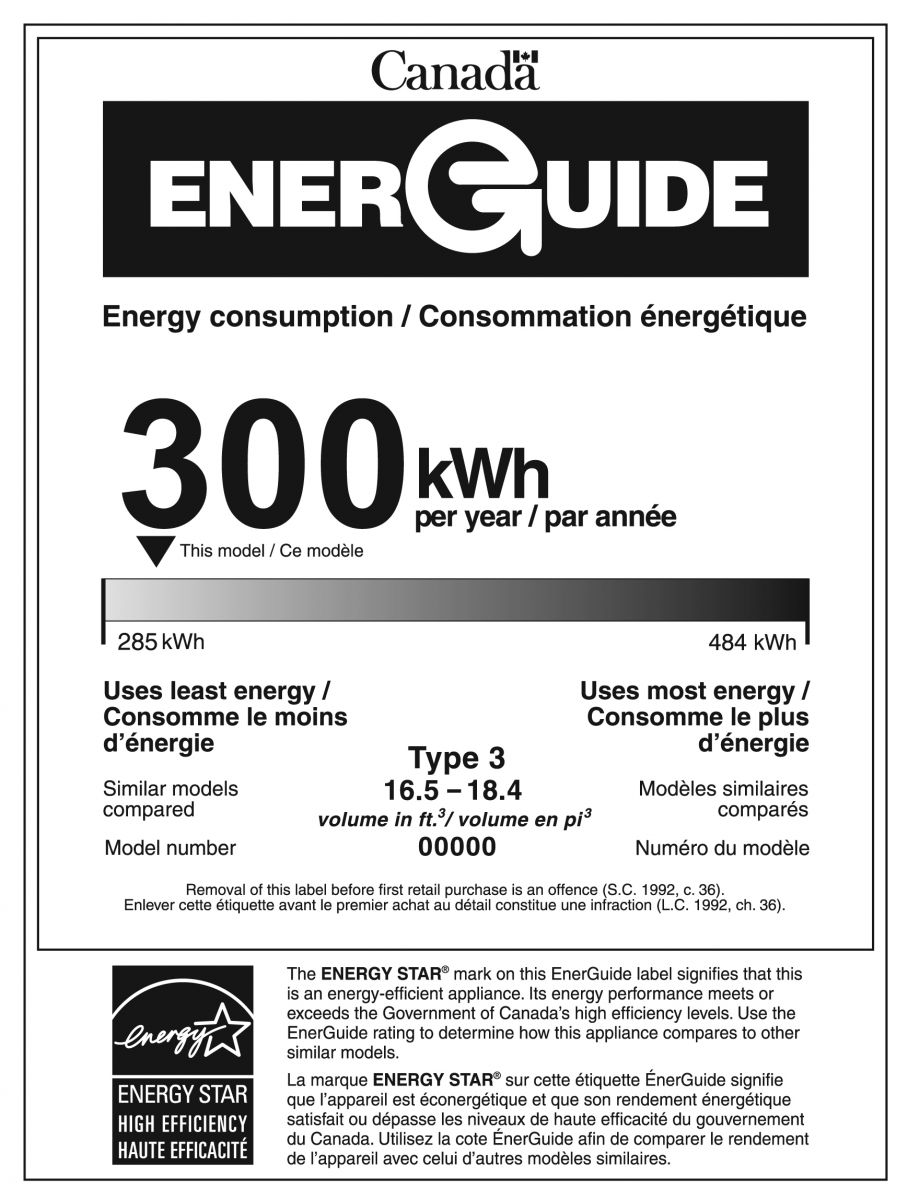
Energy labels have become a useful source of information in consumer decisions when purchasing small and large appliances. The example on the left shows a typical energy label from the European Union, which (currently) uses a rating system from A+++ to A+ and continuing from A through D. The example is particular to refrigerators, and thus also shows information on the storage volume for cooling and freezing, as well as the noise level. Energy efficiency is calculated through an energy efficiency index (EEI) in terms of energy consumption per volume of storage, which in turn is converted into the A+++ to D scale. It may appear that buying a fridge in the A+ is still a relatively green choice. Unfortunately, it isn't. When the standards were established, perhaps A+ was still a relatively "green" choice. Now, the vast majority of devices is in the A+++ to A+ range, and thus the label no longer identifies which device is truly "cutting edge". This phenomenon is something I like to refer to as ecolabel erosion. When technology improves continuously, standards based on outdated EEI calculations lead to a preponderance of top-category labels. The labels become less and less meaningful. What can be done about this ecolable erosion? Are other systems better?

Canada's energy label isn't any better than the EU's. Canada's label is perhaps less appealing at first glance because it is black and white. No colour coding or grade that leads consumers to a quick assessment of the appliance. Instead, the sliding bar indicates where the annual performance ranges compared to "least energy use" and "most energy use". The Canadian system uses classes of similar types as reference, and this can sometimes span a significant range. Unlike the EU system, it is not based on an Energy Efficiency Index but instead on ranking devices within the "peer cohort" as defined by the product type (click on link to see the types of refrigerators). This system suffers from ecolabel erosion as well, because the range that defines best performance and worst performance are increasingly outdated. As a result, the actual performance of a device can sometimes exceed the "best performance"! This is of course a nonsensical result. Without understanding the distribution of efficiencies (or EEIs), ecolabels can defeat the purpose if they suggest that nearly all devices are "efficient". Perhaps they are with respect to technology from twenty years ago, but they are not efficient with respect to today's technical abilities.
‘Ecolabel erosion arises when rating systems remain fixed while technological innovation drives more and more products into the top categories.’
The European Union is already conceding one point: that the A+++ to A+ rating is misleading. The A+, A++ and A+++ classes were added to keep up with technological evolution, but this made it ever harder for consumers to identify the true performance of what they were buying. The EU is deleting the "+" labels and is returning to a new A-G rating. By 2020 most appliances will have a new A-G label, with others following by 2035. To prevent ecolabel erosion, the EU will leave the top class A empty initially in order to promote innovation. This creates an incentive for firms to strive for developing new technologies that meet the "A" standard. Furthermore, the label is to be rescaled once the share of products in the top classes reaches either 30% in the A class or 50% in classes A+B combined. Still, even the new labels will be subject to discrete jumps whenever rescaling is triggered. It is understandable that manufacturers would like to enjoy the "green halo" effect of an A label as long as they can, but the eventual rescaling may lead to undesirable discontinuities with respect to innovation and consumer perception.
Absolute and relative performance
A useful ecolabel (or energy label) provides indications of both absolute and relative performance. Absolute peformance metrics are useful to gauge overall costs. For example, a refrigerator that consumes 300 kWh per year will cost about $36 per year at 12 cents per kWh. Relative performance metrics position the appliance within the available range of choices. It provides information what is best and what is worst in that cohort. Relative performance is a moving target as the range of choices evolves over time.
Ecolabeling will suffer from ecolabel erosion as long as there is technological progress and scales remain fixed for long periods of time. What is "best in class" will thus remain a moving target. Perhaps the only solution is to generate dynamic ecolabels that are updated continuously. The new EU labels will also provide QR codes, which consumers can scan with their smartphones to obtain additional information. Various consumer groups and NGOs are in the process of developing apps to help inform consumers better. QR codes can link in real time to updated informaton on available choices and the relative position of the device that the consumer is investigating for purchase.
What is printed on a label has some persistence, however. The grading scheme with letter grades is perhaps less transparent than a percentile distribution. Why not take all devices in the given category, rank them from best to worth, and provide a percentile rating? For example, a 90th percentile grade would indicate that 90 percent of devices in this category perform worse. A 0-100 score may be more intuitive as a relative scale than letter grades that require mapping of Energy Efficiency Index (EEI) scores into grades. At the very least, devices should show the EEI that they achieve, and show how it compares to the best in class.
How often should relative scores be updated? The EU rules trigger a review every eight years, or sooner if a threshold is exceeded. Eight years is a long time for some technologies, and five years would have been a better choice—after all, we run censuses every five years. The longer horizon for reviews is probably too slow for some product categories where innovation is fast, while for other categories the innovation pace is much slower. Ideally, review standards should be different based on the speed of innovation.
‘International harmonization of ecolabel standards could benefit producers and consumers alike.’
Another concern is the difference in ratings across different countries and jurisdictions. For Canada, perhaps harmonizing labeling standards for consumer productions with the European Union may not be a terrible idea; it would aovid a fair bit of duplication, and the EU Energy label is currently cutting edge. Natural Resources Canada is well aware of these issues and an updated version of their rating system is in the works. Some of their new labels introduce colour and even QR codes, along with a rating system that will be easier to comprehend. Still, there may be an advantage of sharing a rating system, or hamonizing standards, with the European Union or the United States, whichever standard is deemed superior. I reckon that manufacturers would welcome harmonization, reducing the cost of obtaining ecolabels in each different market. It may also reduce consumer confusion when they see competing EU, US, and Canadian energy labels on the same product all showing different numbers and different ratings—a result of differences in testing protocols and rating systems. The current side-by-side comparison (in Canada's case with US energy labels) can erode trust in the accuracy of ecolabels. Instead, international harmonization of ecolabel standards could benefit producers and consumers alike
Canada is also saddled with a plethora of competing provincial energy efficiency regulations. This does not make it easier for manufacturers. This duplication is often cumbersome, and harmonization would be be beneficial. Some of these regulations are meant to exclude certain types of products from markets and set minimum efficiency requirements. What is hard to see is why provinces can't agree on common country-wide standards. (Well, can our provinces agree on anything these days?) Harmonization would amount to simplification, greater transparency, and lower costs.
Further readings and sources:
- BEUC and ANEC: Simplifying the EU Energy Label: Restoring the successful and well-understood closed A to G scheme, 2015.
- European product database for energy labelling.
- European Parliament: Regulation (EU) 2017/1369 of the European Parliament and of the Council of 4 July 2017 setting a framework for energy labelling and repealing Directive 2010/30/EU.
- Natural Resources Canada: Energy Consumption of Major Household Appliances in Canada, 1990-2010.